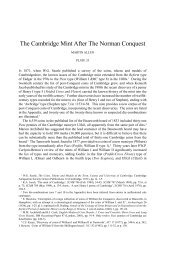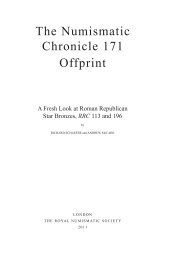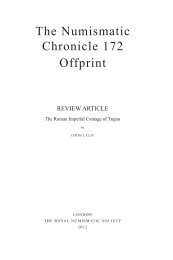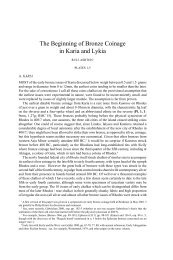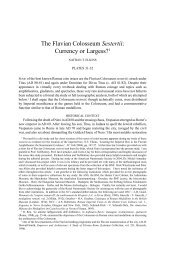Iolkos and Pagasai: Two New Thessalian Mints* - Royal Numismatic ...
Iolkos and Pagasai: Two New Thessalian Mints* - Royal Numismatic ...
Iolkos and Pagasai: Two New Thessalian Mints* - Royal Numismatic ...
You also want an ePaper? Increase the reach of your titles
YUMPU automatically turns print PDFs into web optimized ePapers that Google loves.
IOLKOS AND PAGASAI 33<br />
Classical <strong>and</strong> later sources, including an inscription of the Koinon of the<br />
Magnetes, where, as we have seen, Pagasites is used as a demotic. 72 The same<br />
epithet is given to Apollo by Hesychios (s.v. ���������).<br />
The head on the obverse, which has a modest beauty, is not large; the face is<br />
long <strong>and</strong> delicately worked, without plastic mass. It is framed by hair rendered<br />
on the right as a solid mass, on the left as wavy ringlets. The neck is short; the<br />
eyes are narrow, <strong>and</strong> the eyeballs drawn in linear fashion. The lips, rendered as<br />
parallel lines, enclose a small mouth. These features occur also on the head of<br />
Artemis Iolkia on the bronzes of <strong>Iolkos</strong>.<br />
Chronologically the head is datable near the middle of the 4th century BC <strong>and</strong><br />
recalls the heads on coins of the cities of Magnesia: the Maenad on the bronzes<br />
of Eurea, 73 <strong>and</strong> the eponymous nymph on the coins of Meliboia. 74 There is<br />
some, but less, similarity with the heads on other <strong>Thessalian</strong> coins: the nymph of<br />
Larisa, 75 the Hera of the Gomphoi, 76 the hero (Gyrton?) of Gyrton, 77 the Athena<br />
of Pharsalos, 78 a nymph at Skotoussa, 79 the Lapith Mopsos on the bronzes of<br />
Mopsion, 80 the Hera on the bronzes of Perrhaiboi, 81 <strong>and</strong> the nymph Boura (?) on<br />
an obol of Atrax. 82 There is also a correspondence with a silver coin of Pherai<br />
(350 BC) <strong>and</strong> with its bronzes of the 4th century BC. 83 One may also make<br />
stylistic comparisons with the Apollo on coins from mints outside Thessaly,<br />
such as Amphipolis, 84 Philip II 85 <strong>and</strong> Rhodes. 86 The stylistic congruence of the<br />
head with the general artistic climate of the time is also clear from parallels with<br />
72 Meyer 1942, col. 2298, s.v. <strong>Pagasai</strong>; IG IX 2, 1100, l. 4-5; IG IX 2, 1109, l. 4.<br />
73 Rogers 1932, pp. 74-5, nos 210-1a, fig. 89; Warren 1961, p. 1, Pl. 1, 1 (with a discussion as to<br />
whether Eurea belonged to Magnesia).<br />
74 Rogers 1932, p. 128, no. 390, fig. 204 (1st half of 4th cent. BC); Warren 1961, pp. 1-3, figs 4<br />
(silver), 6 (bronze).<br />
75<br />
Herrmann 1925, p. 41, Pl. 5, nos 4-14 (Group VII, Series A); p. 45, Pl. 7, nos 6-8 (Group VII,<br />
Series M). According to the redating proposed by Martin 1983, pp. 1-34, especially p. 33, this series<br />
belongs to the so-called last phase, dated conventionally between 375-320 BC. Lorber 2000, pp. 8-<br />
12, 14, Pl. 3 (Late II) dates her Late Phase to the period beginning with the interference of Philip II<br />
in the affairs of Thessaly.<br />
76<br />
Rogers 1932, p. 76, no. 214, fig. 92 (2nd half of 4th cent. BC).<br />
77<br />
Rogers 1932, p. 81, no. 229, figs 104-5 (2nd half of 4th cent. BC).<br />
78<br />
Lavva 2001, Pl. 16, nos 354-5. The high chronology proposed by the author, c.424-405/404 BC,<br />
is not convincing. The coins in question belong to the 4th century BC.<br />
79<br />
Rogers 1932, p. 172, no. 543, fig. 300 (1st half of 4th cent. BC).<br />
80<br />
Rogers 1932, pp. 135-6, no. 412, fig. 221 (1st half of 4th cent. BC).<br />
81<br />
Rogers 1932, pp. 143-4, no. 438, fig. 238 (1st half of 4th cent. BC).<br />
82<br />
Demetriadi 2000, pp. 47-8, Pl. 6, no. 1.<br />
83<br />
Moustaka 1983, p. 110, no. 67, Pl. 10 (silver). For the bronze, see Rogers 1932, p. 163, no. 511,<br />
fig. 277.<br />
84<br />
Lorber 1990, Pl. 12, fig. 56 (Type L, c.359/358 BC); Pl. 30, nos 65e-f (370/369 BC).<br />
85<br />
Le Rider 1977, pp. 395-6, Pl. 43, nos 504-6 (Amphipolis II, B).<br />
86 Ashton 2001, nos 100-3 (c.385-late 340s BC).



